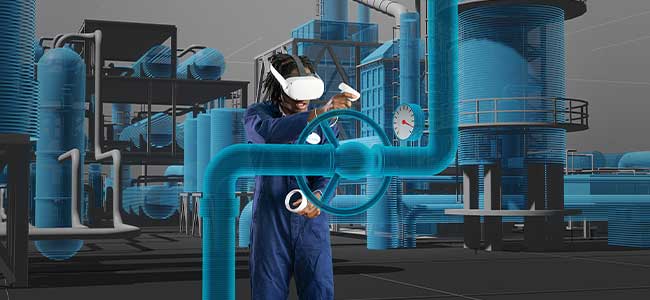
Using VR in Confined Spaces Training
Immersive field simulation takes a whole new approach to help plant workers conduct safety training for working in confined spaces.
- By David Kopf
- May 01, 2023
Virtually reality has been around for some time, but in terms of safety training, VR has only recently entered the industrial world. To that end, in 2019 Honeywell (honeywell.com) unveiled a virtual reality training tool it calls the Immersive Field Simulator, which aims to optimize the results of safety training while making it more accessible.
The IFS creates a virtual reality replica of a real plant that Manas Dutta, the general manager for Honeywell Workforce 360 at Honeywell Process Solutions, refers to as a “digital twin” for the work environment. That twin includes all the equipment, such as pumps, compressors, and valves, found in a plant.
“Then we make it interactive,” he says. “So, the worker who is operating the plant in the real physical world can get the same look and feel in the virtual world. They can interact with it and see what happens if they make any mistakes. They can see the consequences of doing something or how to fix something that isn’t working.”
Essentially, the immersive field simulator helps workers learn in a dynamic environment that is as close to hands-on as you can get, rather than simply reading or watching someone else.
Confined Space Training
And when it comes to confined spaces training, IFS can create a virtual setting that includes all the characteristics of a confined space:
- Limited openings for entry and exit
- Unfavorable natural ventilation
- Potential for dangerous air contaminants
- Not intended for continuous work occupancy
Dutta offers an example of a worker who has to inspect the inside of a tank that will be used to store a hazardous hydrocarbon. Before entering the tank in real life, the worker can use the immersive field simulator (IFS) as a virtual reality experience to simulate many times what it will look like and be like to work inside the tank.
“This simulation provides a 360-degree view of the tank’s interior and can help the worker become familiar with its layout and identify potential hazards,” he explains. “By using the IFS, the worker can learn how to identify potential hazards, and we can assess if they are doing so correctly or if they are missing something.”
By immersing themselves in the virtual environment, workers can get a feel for how to use this equipment in a confined space, such as the tank example. The IFS teaches workers how to use gas detectors, respirators, and harnesses in a confined space before they actually have to use them.
Additionally, VR-based IFS training can prepare workers for emergency situations, such as a leak detected by a gas detector. When workers face such a situation in the simulation, they can be “emotionally connected” to the scenario because the experience is more immediate, according to Dutta. So, in the IFS, their reactions will likely be more realistic than if they were simply watching a video and learning what to do. By providing workers with these immersive experiences, they can learn faster and be better prepared for potential hazards in the field.
“They can approach such a scenario with a much cooler head if something does happen in real life,” he explains.
Improving Engagement
Another benefit of using virtual reality and immersive field simulation is that the tools can use gamification to increase the engagement of the work, Dutta explains. By going beyond step-by-step process education, gamification can help ensure that the worker tries to excel at the lesson.
Also, the IFS means confined spaces safety training now has some flexibility in terms of the logistics of the lessons. Workers don’t have to be in a specific room with all the safety equipment that they carry.
“Now, they can learn from anywhere at any point in time because it’s a device that they can wear and get the complete immersive experience, whether at home, at a desk, or in a workplace,” Dutta explains. “They don’t have to walk to the training room to learn things.”
Instead, a worker could come in 15 minutes before the job to get in what Dutta calls some “bite-sized learning” to refresh a lesson. This learning-as-workers-need-it not only improves productivity but enhances the educational outcome. To that point, a study by PricewaterhouseCoopers (pwc.com) found that people trained with VR were up to 275 percent more confident to act on what they learned after training. That marks a 40 percent improvement over classroom training and a 35 percent gain over e-learn training.
What’s next for VR training? Five years down the line, Dutta says he expects that IFS-based safety training for confined spaces and other environments will be even more experiential. That means that, for example, if a scenario requires a worker to use a fire extinguisher, they will get a better sense of how much pressure is required to operate it effectively.
“The different feedbacks that workers get in the physical world will eventually come into the virtual world,” he explains, “and it’ll make the learning much more realistic.”
Photo credit: Illustration © Honeywell
This article originally appeared in the April/May 2023 issue of Occupational Health & Safety.